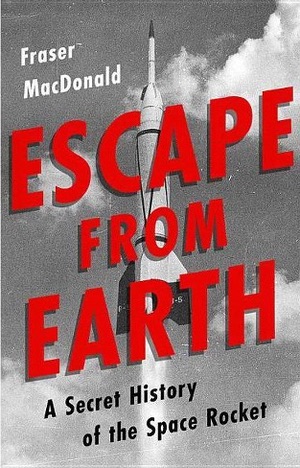Review: Escape from Earthby Jeff Foust
|
| Malina, Parsons, and von KáKármánrmán worked on rocket motors to assist in aircraft takeoffs, founding Aerojet to produce those rockets. The Caltech rocket research group, which did its testing in Arroyo Seco several kilometers from campus, became JPL during the war. |
Malina came to Caltech in the 1930s for graduate school, where he met Parsons and, with the eventual support of professor Theodore von Kármán, started a rocket research program. That work led to support from the US government, including the military, as World War II approached. But while Parsons was increasingly involved in the occult, Malina instead participated in Unit 122, a local Communist Party group that included a number of others involved with the Caltech rocket research effort, such as Chinese scientist Hsue-Shen Tsien.
That affiliation was largely overlooked in the war, as Malina, Parsons, and von Kármán, worked on rocket motors to assist in aircraft takeoffs, founding Aerojet to produce those rockets. The Caltech rocket research group, which did its testing in Arroyo Seco several kilometers from campus, became JPL during the war, working on other rocketry projects as well. It was only after the war, though, during the Red Scare of the late 1940s and 1950s, that the communist affiliations that Malina and others had before the war caused problems; Tsien, for example, was deported to China, becoming the founding father of that country’s rocketry programs.
Malina, in Paris working at the newly established UNESCO, largely avoided the worst of the Red Scare; his passport was revoked for a time and, even though he eventually regained it, he spent the rest of his life in Paris with his family. His rocketry career was long behind him, and he spent his later years as an artist.
| Malina was a member of a communist group and was interested in pursuing rocketry for peaceful purposes. Yet, he worked on military projects, and in the process established a company that would ultimately make him a millionaire. |
While Escape from Earth does devote some sections to Parsons and his increasingly bizarre life before his death in a 1952 explosion, as well as some others involved with the rocketry projects, the central character in the book is Malina. Author Fraser MacDonald, a lecturer at the University of Edinburgh, is clearly a fan of Malina and believes that he has not received the historical attention, and respect, he deserves as a pioneer of rocketry.
That support can go a little too far, though. Malina “is among the most important figures in twentieth-century science,” MacDonald argues. That smacks of hyperbole: is Malina really on the same plane as Einstein and Hawking, or Fleming or Salk? Malina is a major figure in early rocketry, to be certain, and received less attention than some of his contemporaries, but his work in rocketry was relatively brief: he started in the mid 1930s but by the late 1940s had already moved on to UNESCO. By that time American work on rockets focused more on building upon the V-2 technology from Wernher von Braun’s team, larger and more powerful than the rockets developed by JPL.
MacDonald also has trouble grappling with the contradictions posed by Malina’s life. He was, after all, a member of a communist group and was interested in pursuing rocketry for peaceful purposes. Yet, he worked on military projects during the war and shortly thereafter, and in the process established a company that would ultimately make him a millionaire, allowing him to spend the rest of his life in relative comfort, free to pursue his artistic ambitions. MacDonald acknowledges that it was a “strange turn of events that made Frank Malina the first space millionaire,” but never really gets to the root of those events and how much they reflected changes in Malina’s thinking.
Escape from Earth is the most thorough biography of Malina to date, even if it doesn’t come to terms with his contradictions. His story is worthy of more attention, although admittedly it’s not quite the material for a television series.
Note: we are temporarily moderating all comments subcommitted to deal with a surge in spam.
